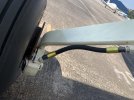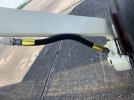There may be a better solution to the rusting pin problem
The 'blue' on firearms is a phosphate process that makes the steel rust resistant, and harder.
Go to a gun store and buy a bottle of the bluing chemical, and follow the directions explicitly, as there are several chemicals that can do the process. There are both liquid and paste versions, I prefer liquid
4 applications using a qtip and re polishing and cleaning produces a good thickness of 'blue'.
Follow with a light oil, rubbed in thoroughly, to fill any pits in the surface, then with a clean cloth and friction only, no solvents, remove the oil as completely as you can. The trace of oil remaining will not hold much dirt. Dry lube to your preference.
If convenient, the inside of the holes in the plates may be done too. Skip the steel wool polishing of the hole!
I have done this to a lot of steel tools, and the results are very satisfying.



